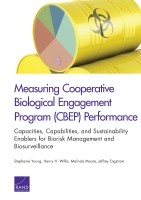| 来源类型 | Research Reports
|
| 规范类型 | 报告
|
| ISBN | 9780833086938
|
| 来源ID | RR-660-OSD
|
| Measuring Cooperative Biological Engagement Program (CBEP) Performance: Capacities, Capabilities, and Sustainability Enablers for Biorisk Management and Biosurveillance |
| Stephanie Young; Henry H. Willis; Melinda Moore; Jeffrey Engstrom
|
| 发表日期 | 2014
|
| 出版年 | 2014
|
| 页码 | 166
|
| 语种 | 英语
|
| 结论 |
To Inform Metric Selection, the Cooperative Biological Engagement Program (CBEP) Needs to- Strengthen enduring partner capabilities for biorisk management
- Strengthen enduring partner capabilities for biosurveillance.
These Objectives Can Be Placed into a Conceptual Framework Built on Logical Models- Logic models establish the sequence from program inputs to activities, outputs, outcomes, and impacts.
- Separate logic models were developed for biosafety, biosecurity, and biosurveillance, each addressing capacities, capabilities, and sustainability enablers.
This Framework Can Be Used to Identify a Candidate Measures- Using these models, an initial list of some 300 metrics was identified from the literature. This list was scored and winnowed down into those metrics that scored most strongly in multiple dimensions.
- Two final lists of recommended metrics emerged, one for use now, one for later introduction.
|
| 摘要 |
- CBEP should take steps to refine and implement the metrics framework to support internal evaluations and external reporting on program impacts. To refine the framework by identifying implementation challenges and mitigation strategies, conduct pilot tests of the recommended metrics in a small set of CBEP partner countries. This approach would allow CBEP to identify challenges and opportunities for refinement in advance of widespread implementation.
- CBEP should also consider moving evaluation efforts forward by focusing on assessing program outcomes in areas key to ultimate program success. Evaluations of lessons learned and best practices would position CBEP to support effectiveness by improving alignment of program activities with program objectives.
|
| 主题 | Biological Weapons and Warfare
; Biosurveillance
; Global Health
; Program Evaluation
; Public Health Preparedness
|
| URL | https://www.rand.org/pubs/research_reports/RR660.html
|
| 来源智库 | RAND Corporation (United States)
|
| 资源类型 | 智库出版物
|
| 条目标识符 | http://119.78.100.153/handle/2XGU8XDN/107765
|
推荐引用方式
GB/T 7714 |
Stephanie Young,Henry H. Willis,Melinda Moore,et al. Measuring Cooperative Biological Engagement Program (CBEP) Performance: Capacities, Capabilities, and Sustainability Enablers for Biorisk Management and Biosurveillance. 2014.
|
|
文件名:
|
x1495316287606.jpg
|
|
格式:
|
JPEG
|

|
文件名:
|
RAND_RR660.pdf
|
|
格式:
|
Adobe PDF
|
除非特别说明,本系统中所有内容都受版权保护,并保留所有权利。